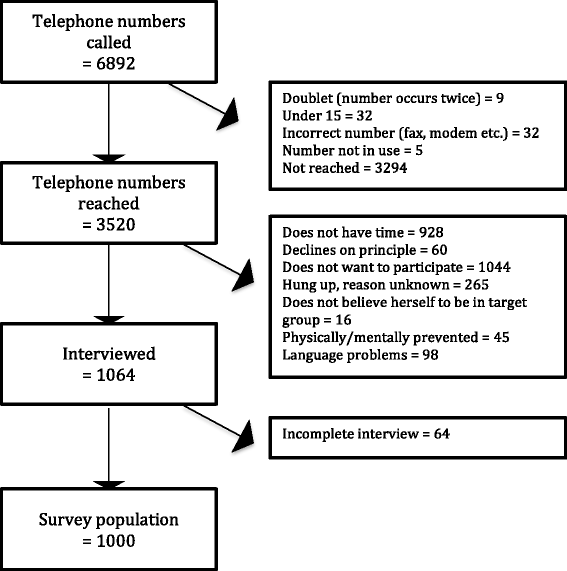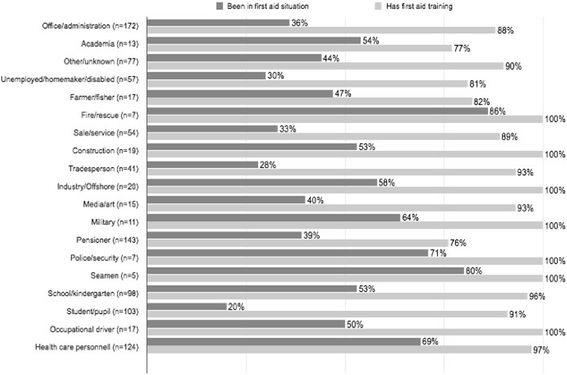A nationwide survey of first aid training and encounters in Norway
- PMID: 28228110
- PMCID: PMC5322636
- DOI: 10.1186/s12873-017-0116-7
A nationwide survey of first aid training and encounters in Norway
Abstract
Background: Bystander first aid can improve survival following out-of-hospital cardiac arrest or trauma. Thus, providing first aid education to laypersons may lead to better outcomes. In this study, we aimed to establish the prevalence and distribution of first aid training in the populace, how often first aid skills are needed, and self-reported helping behaviour.
Methods: We conducted a telephone survey of 1000 respondents who were representative of the Norwegian population. Respondents were asked where and when they had first aid training, if they had ever encountered situations where first aid was necessary, and stratified by occupation. First aid included cardio-pulmonary resuscitation (CPR) and basic life support (BLS). To test theoretical first aid knowledge, respondents were subjected to two hypothetical first aid scenarios.
Results: Among the respondents, 90% had received first aid training, and 54% had undergone first aid training within the last 5 years. The workplace was the most common source of first aid training. Of the 43% who had been in a situation requiring first aid, 89% had provided first aid in that situation. There were considerable variations among different occupations in first aid training, and exposure to situations requiring first aid. Theoretical first aid knowledge was not as good as expected in light of the high share who had first aid training. In the presented scenarios 42% of respondent would initiate CPR in an unconscious patient not breathing normally, and 46% would provide an open airway to an unconscious road traffic victim. First aid training was correlated with better theoretical knowledge, but time since first aid training was not.
Conclusions: A high proportion of the Norwegian population had first aid training, and interviewees reported high willingness to provide first aid. Theoretical first aid knowledge was worse than expected. While first aid is part of national school curriculum, few have listed school as the source for their first aid training.
Keywords: Cardiac arrest; Education; First aid; Laypersons; Legislation; Training; Trauma.
Figures
Similar articles
-
CPR knowledge and attitude to performing bystander CPR among secondary school students in Norway.Resuscitation. 2011 Aug;82(8):1053-9. doi: 10.1016/j.resuscitation.2011.03.033. Epub 2011 Apr 13. Resuscitation. 2011. PMID: 21531067
-
Recent high school graduates support mandatory cardiopulmonary resuscitation education in Australian high schools.Aust N Z J Public Health. 2020 Jun;44(3):215-218. doi: 10.1111/1753-6405.12990. Epub 2020 May 4. Aust N Z J Public Health. 2020. PMID: 32364659
-
Regions With Low Rates of Bystander Cardiopulmonary Resuscitation (CPR) Have Lower Rates of CPR Training in Victoria, Australia.J Am Heart Assoc. 2017 Jun 5;6(6):e005972. doi: 10.1161/JAHA.117.005972. J Am Heart Assoc. 2017. PMID: 28584073 Free PMC article.
-
Evidence-based educational pathway for the integration of first aid training in school curricula.Resuscitation. 2015 Sep;94:8-22. doi: 10.1016/j.resuscitation.2015.06.008. Epub 2015 Jun 18. Resuscitation. 2015. PMID: 26093230 Review.
-
Life supporting first aid training of the public--review and recommendations.Resuscitation. 1999 Jun;41(1):3-18. doi: 10.1016/s0300-9572(99)00034-9. Resuscitation. 1999. PMID: 10459587 Review.
Cited by
-
Implementation of basic life support education for the lay public in China: barriers, enablers, and possible solutions.Front Public Health. 2024 Jun 27;12:1390819. doi: 10.3389/fpubh.2024.1390819. eCollection 2024. Front Public Health. 2024. PMID: 38993705 Free PMC article.
-
Evaluation des connaissances théoriques des étudiants en médecine sur les gestes de premiers secours en République Démocratique du Congo: Theoretical knowledge assessment of medical students on first aid in the Democratic Republic of Congo.Afr J Emerg Med. 2022 Dec;12(4):445-449. doi: 10.1016/j.afjem.2022.10.002. Epub 2022 Nov 2. Afr J Emerg Med. 2022. PMID: 36348739 Free PMC article.
-
Urban residents' self-rescue in response to public health emergencies in China: a qualitative study.BMC Public Health. 2023 Dec 16;23(1):2520. doi: 10.1186/s12889-023-17442-5. BMC Public Health. 2023. PMID: 38104101 Free PMC article.
-
The willingness to perform first aid among high school students and associated factors in Hue, Vietnam.PLoS One. 2022 Jul 27;17(7):e0271567. doi: 10.1371/journal.pone.0271567. eCollection 2022. PLoS One. 2022. PMID: 35895665 Free PMC article.
-
In out-of-hospital cardiac arrest, is the positioning of victims by bystanders adequate for CPR? A cohort study.BMJ Open. 2020 Sep 23;10(9):e037676. doi: 10.1136/bmjopen-2020-037676. BMJ Open. 2020. PMID: 32967879 Free PMC article.
References
-
- Lien Nilsen JM, Bo I, Rasmussen JR, Haanaes EK, Gilbert M. Abstract 17087: doubled survival from out-of-hospital cardiac arrest in a rural community in North-Norway following implementation of an aggressive chest pain protocol with early prehospital thrombolysis for STEMI. Circulation. 2011;124:A17087.
MeSH terms
LinkOut - more resources
Full Text Sources
Other Literature Sources
Medical



